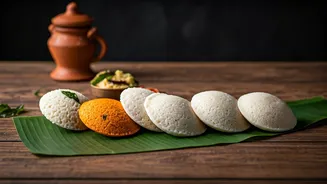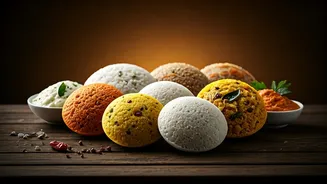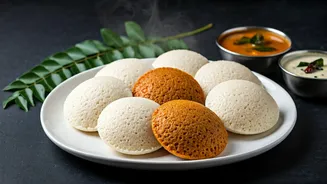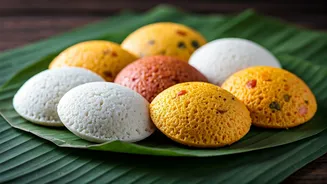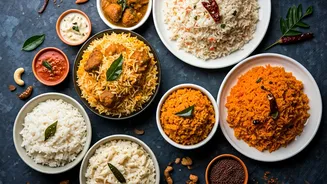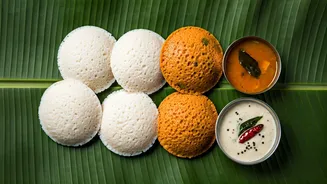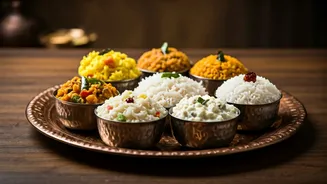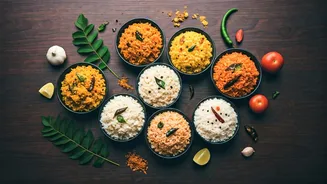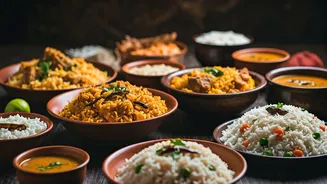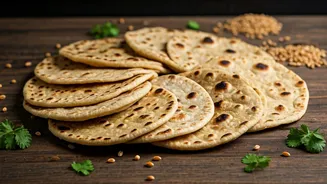Classic Idli
Classic idli is the cornerstone of South Indian breakfast culture, often revered for its simplicity. Made from a batter of fermented rice and urad dal,
it undergoes a steaming process that lends it a soft, airy texture. This straightforward approach provides the foundation for various accompaniments, such as sambar and chutneys. The key to the ideal classic idli lies in the fermentation process; a well-fermented batter results in fluffy, easily digestible idlis. Typically, the classic idli is enjoyed hot, and its bland, clean taste acts as a canvas for the intense flavors of the accompanying dishes. The versatility of the classic idli is what makes it a mainstay in South Indian households. It is a nutritious and light meal, making it suitable for all age groups. It serves as a reminder of South India's culinary expertise, where the simplest elements combine to create something truly delicious.
Rava Idli
Rava idli offers a unique twist on the original recipe, substituting rice with semolina or rava. The resulting idlis have a slightly coarser texture and a subtle nutty flavor. This variation is often prepared quickly, making it a convenient option for busy mornings. To enhance the flavor and texture, rava idli often incorporates ingredients like yogurt, cashew nuts, mustard seeds, and curry leaves. The preparation typically includes roasting the rava before adding it to the batter to avoid the raw taste. The addition of ingredients provides a contrasting texture to the softness of the idli. This dish presents a welcome change for those who enjoy the classic idli but want to explore different textures and taste profiles. Served with coconut chutney and sambar, rava idli provides a quick, tasty, and satisfying meal.
Kanchipuram Idli
Kanchipuram idli is a flavorful and spiced version, named after the temple town of Kanchipuram in Tamil Nadu. The batter incorporates various spices and lentils, creating a much bolder flavor than the original. Typically, the ingredients include ginger, asafoetida, cumin, and black peppercorns, all providing a flavorful twist. This idli is often steamed in small, conical containers, giving it a distinctive shape. The addition of spices not only enhances the taste but also aids in digestion, a significant aspect of traditional Indian cooking. The preparation of Kanchipuram idli involves a complex fermentation process and the use of specially crafted equipment. Kanchipuram idli provides a culinary experience, showcasing the diverse flavors and culinary traditions of South India, a must-try for those looking to expand their idli experience.
Thatte Idli
Thatte idli, which translates to 'plate idli,' is recognizable due to its circular, plate-like form. Prepared in Karnataka, these idlis are bigger and thicker than standard versions, lending a softer, fluffier texture. This size difference results from the unique steaming method used. The use of a larger plate allows for more batter to be poured, resulting in substantial, filling idlis, perfect for a hearty breakfast. Thatte idlis often come with flavorful accompaniments like chutney and sambar. Their size and texture contribute to a more satisfying meal, making them a popular choice. The distinct shape and soft texture set thatte idli apart. This variation offers a unique South Indian breakfast experience.
Muthu Idli
Muthu idli, which means 'pearl idli,' showcases a mini version of the regular idli. They are small, spherical, and bite-sized, perfect for quick eating. Often, these idlis are steamed using special molds that shape them into their distinctive form. This type is generally served in smaller portions, making them an excellent choice for kids or as a part of a variety of dishes. Due to their size, muthu idlis cook faster, which also gives them a softer consistency. Muthu idlis are often included in South Indian thalis or served as a starter. Their convenience and appeal make them a fun and practical choice. They offer a delightful variation of a popular breakfast staple.
Moong Dal Idli
Moong dal idli offers a healthier variation of the original, with the use of moong dal as the primary ingredient. This recipe incorporates soaked moong dal ground into a paste, often combined with rice flour and spices. The resulting idlis are light, packed with nutrients, and rich in protein. Moong dal idlis often include ingredients like ginger, green chilies, and cumin seeds, adding flavor and health benefits. They are particularly beneficial for those with dietary restrictions or those looking for a healthier choice. This version showcases how South Indian cooking adapts to nutritional needs without sacrificing flavor. Moong dal idlis offer a healthy, tasty alternative, providing a nutritious start to the day.
Idli with Variations
Beyond the traditional and commonly available types, idli also comes in a range of variations that depend on regional and individual preferences. Some innovative versions incorporate ingredients like oats, ragi, or other grains for added nutritional value and different textures. Flavored idlis with ingredients like vegetables, lentils, or spices are also popular. Some households experiment by adding ingredients like vegetables, spices, and nuts to the batter. These add-ons create varied textures and flavors, enhancing the idli. These variations reveal the versatility of the idli as a dish that can be customized to suit individual tastes and nutritional needs. This ongoing innovation ensures that this breakfast staple will keep evolving.
